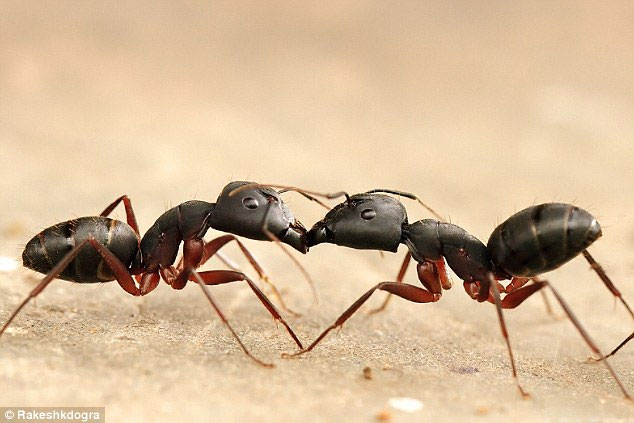A new study shows that the behavior of ants regurgitating food into each other’s mouths is not only for sharing food but also for forming social relationships.
According to livescience.com, in this new study, Dr. Adria LeBoeuf, Director of the Social Fluid Laboratory at the University of Fribourg in Switzerland, stated that most insects have a foregut, midgut, and hindgut. However, in social insect species, the foregut has become a type of “social stomach.” The food in the midgut and hindgut is digested, while the food in the foregut is meant for sharing.

When ants regurgitate food into each other’s mouths, they are not just exchanging nutrients. (Illustration: Dailymail).
The behavior of transferring food from one ant to another by regurgitating is very common in highly social species like ants. During such an exchange, nutrients and proteins are transferred from one ant’s “social stomach” to another. Through this series of food exchanges, ants form a social circulatory system, connecting members of the ant colony with one another.
Wood ants continuously share nutrients in this manner. In a colony, there can be up to 20 food exchanges in just one minute. A colony can consist of thousands of ants.
Dr. LeBoeuf stated: “Five years ago, we published a study saying that the behavior of food exchange is not only a way to share food but also transmits hormones, recognition signals among nest mates, small RNA fragments, and other substances.”
Therefore, when ants regurgitate food into each other’s mouths, they are not merely exchanging nutrients. Instead, they are creating a digestive social network, through which information and energy continuously circulate within the ant colony for those who need it. This phenomenon is very similar to how the human brain releases hormones into the bloodstream to reach the liver.
An ant colony is not just a collection of individual ants but also a “superorganism,” meaning the entire colony operates as a single entity. Just as the human body has tissues and organs performing tasks to achieve a common goal, ant colonies have different roles that can be considered as parts or tissues of the superorganism. Some ants forage for food, some care for the young, and others dig the nest…
To help understand why ants share food in the foregut, scientists explored whether the proteins they exchange are related to individual roles within the colony or the life cycle of the ant colony.
In most recent experiments, Dr. LeBoeuf and her colleagues analyzed food in the social stomachs of wood ants both in natural colonies and in the laboratory. Through samples, they identified 519 types of proteins transmitted within the ant colony, with 27 types present in all samples.
Worker ants seem to forage for food, convert that food into specific proteins, and then share it with others. As the ant colony grows, more nutrients are stored.
Adult ants may not even need to eat; they can gradually digest these stored proteins.
The research results indicate that some members of the ant colony may perform circulatory tasks for the benefit of others. There are foods consumed by one ant that appear in another, and researchers find this very intriguing.
However, many questions remain. For example, the research team found that worker ants have higher levels of stored proteins than foragers, yet foragers produce these proteins more quickly.
Studying the system of nutritional exchanges in ants could help scientists better understand how circulatory tasks are divided among individual organisms.
The study was published on November 2 in the journal eLife.


















































